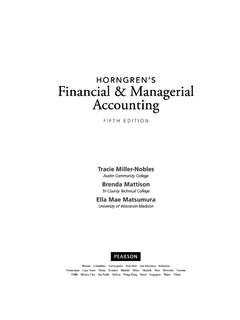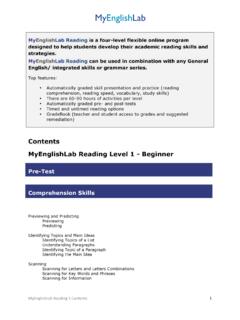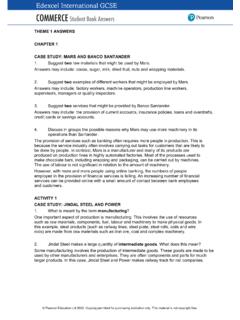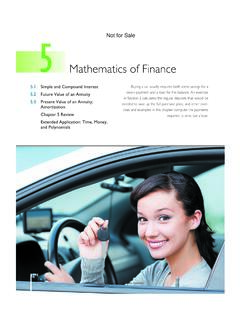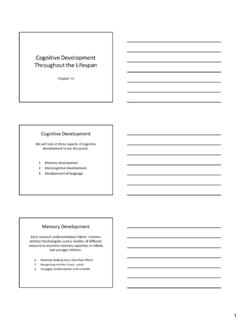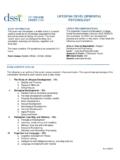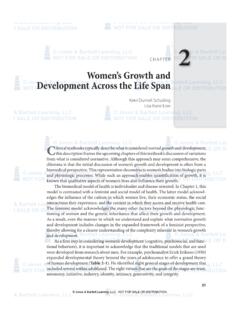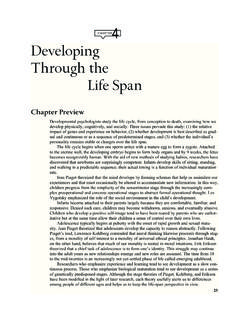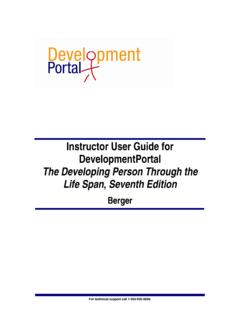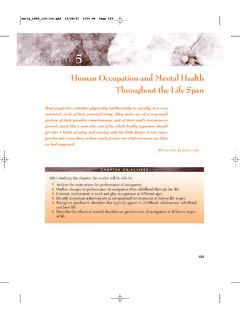Transcription of Development Through the Lifespan, 7/e - Pearson
1 Sample ChapterDevelopment Through the lifespan , 7/eLaura E. BerkISBN: 9780134419695 Copyright 2018 Laura E. Berk. All rights is prohibited without the written authorization of the begins on next page >PLEASE NOTE: This sample chapter was prepared in advance of book publication. Additional changes may appear in the published request an examination copy or for additional information, please visit us at or contact your Pearson representative at 2018 Laura E. Berk. All rights reserved. PHOTODISC/GREEN/RF/GETTY IMAGE436 Physical and Cognitive Development in Early Adulthoodchapter 13 Early adulthood brings momentous changes among them, choosing a vocation, starting full-time work, and attaining economic independence. This Dutch computer game designer and animator works in a field that combines an interest in gaming with artistic abilities.
2 AKG-IMAGES/PICTURECONTACT/THE IMAGE WORKSC opyright 2018 Laura E. Berk. All rights s ahead in chapter 13 PHYSICAL DEVELOPMENTB iological Aging Is Under Way in Early AdulthoodAging at the Level of DNA and Body Cells t Aging at the Level of Tissues and Organs BIOLOGY AND ENVIRONMENT Telomere Length: A Marker of the Impact of Life Circumstances on Biological AgingPhysical ChangesCardiovascular and Respiratory Systems t Motor Performance t Immune System t Reproductive CapacityHealth and FitnessNutrition t Exercise t Substance Abuse t Sexuality t Psychological StressCOGNITIVE DEVELOPMENTC hanges in the Structure of ThoughtEpistemic Cognition t Pragmatic Thought and Cognitive-Affective ComplexityExpertise and CreativityThe College ExperiencePsychological Impact of Attending College t Dropping Out SOCIAL ISSUES: EDUCATION How Important Is Academic Engagement in College for Successful Transition to the Labor Market?
3 Vocational ChoiceSelecting a Vocation t Factors Influencing Vocational Choice t Vocational Preparation of Non-College-Bound Young Adults CULTURAL INFLUENCES Masculinity at Work: Men Who Choose Nontraditional CareersThe back seat and trunk piled high with belongings, 23-year-old Sharese hugged her mother and brother goodbye, jumped in the car, and headed toward the interstate with a sense of newfound freedom mixed with apprehension. Three months earlier, the family had watched proudly as Sharese received her bachelor s degree in chemistry from a small university 40 miles from her home. Her college years had been a time of gradual release from economic and psychological dependency on her family. She returned home periodically on weekends and lived there during the summer months. Her mother supplemented Sharese s loans with a monthly allowance.
4 But this day marked a turning point. She was moving to her own apartment in a city 800 miles away, with plans to work on a master s degree. With a teaching assistantship and a student loan, Sharese felt more on her own than at any previous time in her her college years, Sharese made lifestyle changes and settled on a vocational direction. Overweight throughout high school, she lost 20 pounds in her sophomore year, revised her diet, and began an exercise regimen by joining the university s Ultimate Frisbee team, eventually becoming its captain. A sum-mer spent as a counselor at a camp for chroni-cally ill children helped convince Sharese to apply her background in science to a career in public , two weeks before she was to leave, Sharese confided in her mother that she had doubts about her decision. Sharese, her mother advised, we never know if our life choices are going to suit us just right, and most times they aren t perfect.
5 It s what we make of them how we view and mold them that turns them into successes. So Sharese embarked on her journey and found herself face-to-face with a multitude of exciting challenges and this chapter, we take up the physical and cognitive sides of early adulthood, which extends from ages 18 to 40. As noted in Chapter 1, the adult years are difficult to divide into discrete periods because the timing of important milestones varies greatly among individuals much more so than in childhood and adolescence. But for most people, early adulthood involves a common set of tasks: leaving home, completing education, beginning full-time work, attaining economic independence, establishing a long-term sexually and emotionally intimate relationship, and starting a family. These are energetic decades filled with momentous decisions that, more than any other time of life, offer the potential for living to the fullest.
6 MARTY HEITNER/THE IMAGE WORKSC opyright 2018 Laura E. Berk. All rights 13 Physical and Cognitive Development in Early AdulthoodPHYSICAL DEVELOPMENTT hroughout childhood and adolescence, the body grows larger and stronger, coordination improves, and sensory systems gather information more effectively. Once body structures reach maxi-mum capacity and efficiency, biological aging, or senescence, begins genetically influenced declines in the functioning of organs and systems that are universal in all members of our spe-cies. Like physical growth, however, biological aging varies widely across parts of the body, and individual differences are great variation that the lifespan perspective helps us under-stand. A host of contextual factors including each person s genetic makeup, lifestyle, living environment, and historical period can accelerate or slow age-related declines (Arking, 2006).
7 As a result, the physical changes of the adult years are, indeed, multidimensional and multidirectional (see page 8 in Chapter 1).In the following sections, we examine the process of biologi-cal aging. Then we turn to physical and motor changes already under way in early adulthood. As you will see, biological aging can be modified substantially Through behavioral and environ-mental interventions. During the twentieth century, improved nutrition, medical treatment, sanitation, and safety added 25 to 30 years to average life expectancy in industrialized nations, a trend that is continuing (see Chapter 1, page 7). We will take up life expectancy in greater depth in Chapter Aging Is Under Way in Early Describe current theories of biological aging, both at the level of DNA and body cells and at the level of tissues and an intercollegiate tournament, Sharese dashed across the play-ing field, leaping high to catch Frisbees sailing her way.
8 In her early twenties, she is at her peak in strength, endurance, sensory acuteness, and immune system responsiveness. Yet over the next two decades, she will age and, as she moves into middle and late adulthood, will show more noticeable declines. Biological aging is the combined result of many causes, some operating at the level of DNA, others at the level of cells, and still others at the level of tissues, organs, and the whole organism. Despite hun-dreds of theories and the efforts of many researchers, our under-standing of the mechanisms of biological aging is at the Level of DNA and Body CellsCurrent explanations of biological aging at the level of DNA and body cells are of two types: (1) those that emphasize the programmed effects of specific genes and (2) those that empha-size the cumulative effects of random events that damage genetic and cellular material.
9 Support for both views exists, and a combi-nation may eventually prove to be programmed aging receives some support from kinship studies indicating that longevity is a family trait. People whose parents had long lives tend to live longer themselves. And greater similarity exists in the lifespans of identical than fraternal twins. But the heritability of longevity is low to moderate, rang-ing from .15 to .50 for age at death and from .15 to .55 for vari-ous measures of current biological age, such as hand-grip muscle strength, respiratory capacity, blood pressure, bone density, and overall physical health (Dutta et al., 2011; Finkel et al., 2014). Rather than inheriting longevity directly, people probably inherit risk and protective factors, which influence their chances of dying earlier or genetic programming theory proposes the existence of aging genes that control biological changes, such as meno-pause, efficiency of gross motor skills, and deterioration of body cells.
10 The strongest evidence for this view comes from research showing that human cells allowed to divide in the laboratory have a lifespan of 50 divisions, plus or minus 10 (Hayflick, 1998). With each duplication, a special type of DNA called telomeres located at the ends of chromosomes, serving as a This whitewater kayaker, in his early twenties, is at his peak in strength, endurance, and sensory acuteness. MOODBOARD/ALAMYA young adult takes a selfie with her 85-year-old grandmother. Longevity tends to run in families, though people probably inherit risk and protective factors rather than length of life 2018 Laura E. Berk. All rights 13 Physical and Cognitive Development in Early Adulthood439 Telomere Length: A Marker of the Impact of Life Circumstances on Biological Agingperiods of telomere change times when telomeres are most susceptible to modifi-cation.


